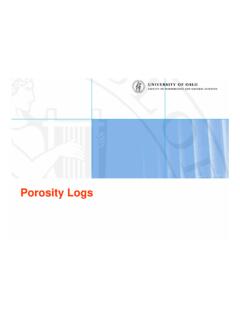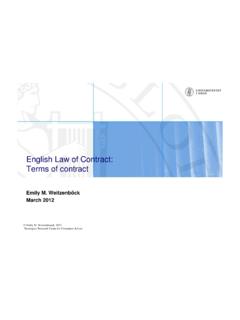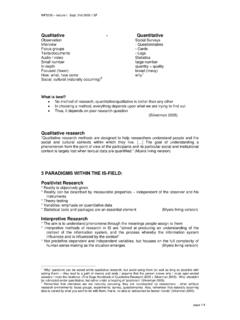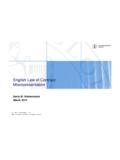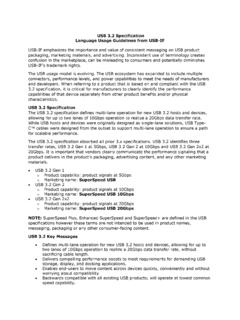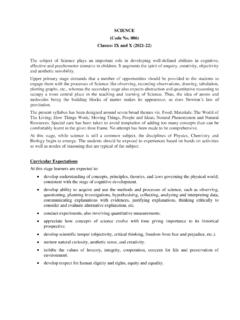Transcription of Fatty Acids: Structures and Introductory article Properties
1 Fatty Acids: Structures andPropertiesArild C Rustan,University of Oslo, Oslo, NorwayChristian A Drevon,University of Oslo, Oslo, NorwayFatty acids play a key role in metabolism: as a metabolic fuel, as a necessary component ofall membranes, and as a gene regulator. In addition, Fatty acids have a number of acids, both free and as part of complex lipids, play anumber of key roles in metabolism major metabolic fuel(storage and transport of energy), as essential componentsof all membranes, and as gene regulators (Table 1). In ad-dition, dietary lipids provide polyunsaturated Fatty acids(PUFAs) that are precursors of powerful locally actingmetabolites, the eicosanoids. As part of complex lipids, Fatty acids are also important for thermal and electricalinsulation, and for mechanical protection. Moreover, freefatty acids and their salts may function as detergents andsoaps owing to their amphipathic Properties and the for-mation of of Fatty Acid StructureFatty acids are carbon chains with a methyl group at oneend of the molecule (designated omega,o) and a carboxylgroup at the other end (Figure 1).
2 The carbon atom nextto the carboxyl group is called theacarbon, and thesubsequent one thebcarbon. The letternis also often usedinstead ofthe Greekoto indicate thepositionof thedoublebond closest to the methyl end. The systematic nomencla-ture for Fatty acids may also indicate the location of doublebonds with reference to the carboxyl group (D).Figure 2outlines the Structures of different types of naturallyoccurring Fatty Fatty acidsSaturated Fatty acids are filled (saturated) with saturated Fatty acids are straight hydrocarbon chainswith an even number of carbon atoms. The most commonfatty acids contain 12 22 carbon Fatty acidsMonounsaturated Fatty acids have one carbon carbondouble bond, which can occur in different positions. Themost common monoenes have a chain length of 16 22 anda double bond with thecisconfiguration. This means thatthe hydrogen atoms on either side of the double bond areoriented in the same may be pro-duced during industrial processing (hydrogenation) of un-saturated oils and in the gastrointestinal tract ofruminants.
3 The presence of a double bond causes restric-tion in the mobility of the acyl chain at that point. Thecisconfiguration gives a kink in the molecular shape andcisfatty acids are thermodynamically less stable than thetransforms. Thecisfatty acids have lower melting points thanthetransfatty acids or their saturated polyunsaturated Fatty acids (PUFAs) the first doublebond may be found between the third and the fourth car-bon atom from theocarbon; these are calledo-3 fattyacids. If the first double bond is between the sixth andseventh carbon atom, then they are calledo-6 Fatty double bonds in PUFAs are separated from each otherby a methylene ContentsIntroductory of Fatty Acid Fatty of Fatty of Fatty for and Uses of Fatty Acids in of Fatty Acids in the Pharmaceutical/PersonalHygiene Industriesdoi: (CH )n CH CH COOH32 2 2 Figure 1 nomenclature for Fatty acids. Fatty acids may be namedaccording to systematic or trivial nomenclature . One systematic way todescribe Fatty acids is related to the methyl (o) end.
4 This is used to describethe position of double bonds from the end of the Fatty acid. The letternisalso often used to describe theoposition of double 1 Functions of Fatty acidsEnergy high per gram (37 kJ g21fat)Transportable form of energy blood lipids ( triacyl-glycerol in lipoproteins)Storage of energy, in adipose tissue and skeletal muscleComponent of cell membranes (phospholipids)Insulation thermal, electrical and mechanicalSignals eicosanoids, gene regulation (transcription)1 ENCYCLOPEDIA OF LIFE SCIENCES&2005, John Wiley & Sons, Ltd. , which are produced only by plants and phyto-plankton, are essential to all higher organisms, includingmammals and ando-6 Fatty acids cannot be in-terconverted, and both are essential nutrients. PUFAs arefurther metabolized in the body by the addition of carbonatoms and by desaturation (extraction of hydrogen).Mammals have desaturases that are capable of removinghydrogens only from carbon atoms between an existingdouble bond and the carboxyl group (Figure3).
5 B-oxidationof Fatty acids may take place in either mitochondria Fatty AcidsFatty acids represent 30 35% of total energy intake inmany industrial countries and the most important dietarysources of Fatty acids are vegetable oils, dairy products,meat products, grain and Fatty fish or fish most common saturated Fatty acid in animals,plants and microorganisms is palmitic acid (16:0). Stearicacid (18:0) is a major Fatty acid in animals and some fungi,and a minor componentin most plants. Myristic acid (14:0)has a widespread occurrence, occasionally as a major com-ponent. Shorter-chain saturated acids with 8 10 carbonatoms are found in milk and coconut acid (18:1o-9) is the most common monoenoicfatty acid in plants and animals. It is also found in micro-organisms. Palmitoleic acid (16:1o-7) also occurs widely inanimals, plants and microorganisms, and is a major com-ponent in some seed acid (18:2o-6) is a major Fatty acid in plantlipids. In animals it is derived mainly from dietary plantoils.
6 Arachidonic acid (20:4o-6) is a major component ofmembrane phospholipids throughout the animal king-dom, but very little is found in the acid(18:3o-3) is found in higher plants (soyabean oil and rapeseed oils)andalgae. Eicosapentaenoicacid (EPA; 20:5o-3)and docosahexaenoic acid (DHA; 22:6o-3) are major fattyacids of marine algae, Fatty fish and fish oils; for example,DHA is found in high concentrations, especially inphospholipids in the brain, retina and of Fatty AcidsAn adult consumes approximately 85 g of fat daily, most ofit as triacylglycerols. During digestion, free Fatty acidsStearic 18:0 -characteristicsOleic 18:1, -9 Linoleic 18:2, -6 -Linolenic 18:3, -3 EPA 20:5, -3 DHA 22:6, -3 Methyl endSaturationCarboxylend9996912153173141 15819316131074 -characteristicsCOOHCOOHCOOHCOOHCOOHCOOH P olyeneSaturateMonoenePolyenePolyenePolye ne18:018:1 918:2 9,1218:3 9,12,1520:5 5,8,11,14,1720:6 4,7,10,13,16,19 Figure2 Structure of different unbranched Fatty acids with a methylend and acarboxyl (acidic) end.
7 Stearic acid isa trivial namefor a saturated Fatty acidwith 18 carbon atoms and no double bonds (18:0). Oleic acid has 18 carbon atoms and one double bond in theo-9 position (18:1o-9), whereaseicosapentaenoic acid (EPA), with multiple double bonds, is represented as 20:5o-3. This numerical scheme is the systematic nomenclature mostcommonly used. It is also possible to describe Fatty acids systematically in relation to the acidic end of the Fatty acids; symbolizedD(Greek delta) andnumbered 1. All unsaturated Fatty acids are shown withcisconfiguration of the double bonds. DHA, docosahexaenoic 18:2 -Linolenic 18:3 6-desaturase -Linolenic 18:3 Octadecatetraenoic 18:4elongaseDihomo- -linolenic 20:3 Eicosatetraenoic 20:4 5-desaturase Arachidonic 20:4 Eicosapentaenoic 20:5 elongaseAdrenic 22:4 Docosapentaenoic 22:5 elongaseTetracosatetraenoic 24:4 Tetracosapentaenoic 24:5 6-desaturase Tetracosapentaenoic 24:5 Tetracosahexaenoic 24:6 -oxidation Docosapentaenoic 22:5 Docosahexaenoic 22:6 -3 Fatty acids -6 Fatty acidsEnzymes Figure 3 Synthesis ofo-3 ando-6 polyunsaturated Fatty acids (PUFAs).
8 There are two families of essential Fatty acids that are metabolized in thebody as shown in this figure. Retroconversion, DHA!EPA also Acids: Structures and Properties2(FFA) and monoacylglycerols are released and absorbedin the small intestine. In the intestinal mucosa cells, FFAare re-esterified to triacylglycerols, which are transportedvia lymphatic vessels to the circulation as part of chylo-microns. In the circulation, Fatty acids are transportedbound to albumin or as part of are taken up into cells mainly by protein trans-porters in the plasma membrane and are transported in-tracellularly via Fatty acid-binding proteins (FABP)(Figure 4). FFA are then activated (acyl-CoA) before theyare shuttled via acyl-CoA-binding protein (ACBP) to mi-tochondria or peroxisomes forb-oxidation (and formationof energy asATP and heat) or to endoplasmicreticulum foresterification to different classes of lipid. Acyl-CoA or cer-tain FFA may bind to transcription factors that regulategene expression or may be converted to signal molecules(eicosanoids).
9 Glucose may be transformed to Fatty acids(lipogenesis) if there is a surplus of glucose/energy in of Fatty AcidsPhysical propertiesFatty acids are poorly soluble in water in their undissoci-ated (acidic) form, whereas they are relatively hydrophilicas potassium or sodium salts. Thus, the actual water sol-ubility, particularly of longer-chain acids, is often verydifficult to determine since it is markedly influenced by pH,and also because Fatty acids have a tendency to associate,leading to the formation of monolayers or micelles. Theformation of micelles in aqueous solutions of lipids is as-sociated with very rapid changes in physical propertiesover a limited range of concentration. The point of changeis known as the critical micellar concentration (CMC), andexemplifies the tendency of lipids to associate rather thanremain as single molecules. The CMC is not a fixed valuebut represents a small concentration range that is markedlyaffected by the presence of other ions and by acids are easily extracted with nonpolar solventsfrom solutions or suspensions by lowering the pH to formthe uncharged carboxyl group.
10 In contrast, raising the pHincreases water solubility through the formation of alkalimetal salts, which are familiar as soaps. Soaps have im-portant Properties as association colloids and are surface-active influence of a Fatty acid s structure on its meltingpoint is such that branched chains andcisdouble bondswill lower the melting point compared with that of equiv-alent saturated chains. In addition, the melting point of afatty acid depends on whether the chain is even- or odd-numbered; the latter have higher melting Fatty acids are very stable, whereas unsatu-rated acids are susceptible to oxidation: the more doubleATP formation andheat dissipationGlucoseGlucoseFFAAcyl-CoAACBP P eroxisomeFABPA lbuminMitochondrionEsterificationLipogen esisActivationOxidationTransporterFFAP hospholipidsCholesteryl estersTriglycerides Gene interaction Eicosanoids Modulation of enzymes/proteins Elongation/desaturationFigure 4 Metabolism of Fatty acids. Free Fatty acids (FFA) are taken up into cells mainly by protein carriers in the plasma membrane and transportedintracellularly via Fatty acid-binding proteins (FABP).
